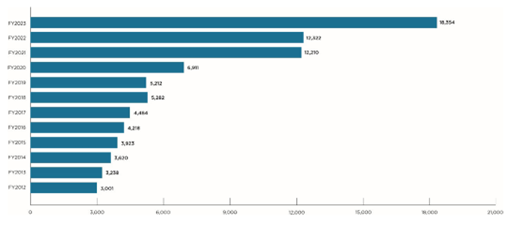On November 14, 2023 the Securities and Exchange Commission (SEC) released its annual Office of the Whistleblower Report to Congress for fiscal year 2023 (October 1, 2022-September 30, 2023). This report highlighted several findings that demonstrate growing trends in external reporting and subsequent rewards to whistleblowers.
While this agency report is always illuminating, and the trends in reporting continue to shed light on a larger cultural shift towards reporting misconduct and unethical behavior, there are three key points that stand out as particularly interesting, especially when paired with our own NAVEX data on internal reporting.
1. The SEC received the largest number of tips in one year since the program began, by far
Let’s start with the sheer number of tips received – and a picture from the report is worth a thousand words here.

For FY2023, the Office of the Whistleblower (OWB) received a record amount of whistleblower tips, with 18,354 reports filed. Compared to last year which was also a record-breaking reporting year with 12,322 tips in FY2022, this 49% increase demonstrates people are clearly aware of this reporting option and are comfortable using it. It also demonstrates the global reach of the program.
One cannot look at this chart and not be struck by how large the difference is between FY2022 and 2023 – 6,032 reports is a lot. In fact, the difference alone amounts to more reports than each of the fiscal years from its inception in 2012 until 2019.
Jane Norberg, the former Chief of the Office of the Whistleblower at the SEC and now a partner at Arnold & Porter who assists companies with whistleblower issues, internal investigations, and SEC defense, told us the increase “may be due to a number of factors including the very large awards announced recently, general awareness of the program, and less stigma around reporting.”
What does NAVEX data show for internal reporting?
Internal reports are on the rise, too. At NAVEX, our data is typically compiled on a calendar year basis. For the sake of an apples-to-apples comparison, we specifically ran the data from our own reporting systems adjusted to align to the SEC fiscal year (October through September each year). Looking at reports received from October 1, 2022 through September 30, 2023 (FY2023), NAVEX also saw an increase in total reporting, 15%, and all-time high in internal reporting for us:
- A record number of reports in the same time period, with over 1.72 million reports raised during the SEC FY2023
- Comparatively, using the SEC FY2022, NAVEX received 1.50 million reports, which was previously a record year
- Reports per 100 employees for the same time period saw an increase across the same FY2022 and FY2023, with 1.44 and 1.46 reports per 100 employees respectively
What does the increase in internal and external reporting mean?
First and foremost, this means employees, and to some extent, third parties, are indeed speaking up more – and that is unequivocally a good thing. That said, as we predicted in last year’s Top 10 Trends in Risk & Compliance, “Whistleblowers (reporters) have shown in recent years they are more willing to take their concerns outside the organization if the issue is not addressed in a timely and appropriate way, as evidenced by the high levels of reporting to the SEC Office of the Whistleblower as well as the growth of social media sites like Glassdoor.” This prediction holds up against the test of time.
2. A comparison of internal financial reporting rates against external SEC reporting rates shows a noteworthy discrepancy
While the SEC has seen such a significant increase in reporting to the agency, the NAVEX data offers a warning to internal programs. Median internal reporting rates of issues related to Accounting, Auditing and Financial Controls have been dropping over the last three years. When comparing the same fiscal year periods as the SEC, the median number of accounting related reports dropped from 4.7% in FY2021 to 4.3% in FY2023. Organizations experiencing a decline in accounting related reports may want to review their processes and communications to ensure employees are comfortable raising these types of concerns.
3. Increased enforcement on impeding whistleblowing to government agencies is a priority
Recently, several cases demonstrate an increase in enforcement against companies that impede employees from reporting externally. This can take many forms, including language in employment contracts prohibiting external reporting, non-disclosure agreements upon departure and the like.
The SEC OWB Report mentions several of the companies that were held accountable for violating Rule 21F-17, which states, “[n]o person may take an action to impede an individual from communicating directly with the Commission staff about a possible securities law violation.”
Outlined in this year’s report were several companies found to have violated this rule. Examples provided include language in separation agreements requiring former employees to notify the company about external reporting, making separation pay conditional by requiring employees to certify they had not filed a complaint against the company, and requiring certain departing employees to waive their rights to monetary awards for external reports.
Among the many points that are made clear in this report, the SEC’s priority to ensure external reporting is not suppressed or discouraged by the company rises to the top.
“OWB assists investigative and examinations staff in identifying actions that impeded individuals’ abilities to report potential wrongdoing to the Commission as well as assessing instances of adverse employment actions taken against employees.”
Norberg noted that “many of the companies charged with impeding reporting this year had some form of language allowing for government reporting but they either did not go far enough or had contradictory or missing language in the document. I would put this issue on the top of your annual compliance review because I predict this will continue to be a focus of the SEC in the upcoming year.”
Best practices in encouraging reporting and addressing allegations of misconduct
As reports to, and awards from, the SEC Office of the Whistleblower continue to rise, this trend will likely persist. However, this unprecedented rise in external reporting does beg the question, “why are these reports not being raised internally first?”
First, we need to note the SEC no longer includes the metric on whether an external report (SEC tip) was raised internally first. Without this data, we’re left to speculate a bit more than we’d like, but if history is any indicator, in 2021, more than 75% of reporters did raise their concerns internally before reporting to the SEC. And we note that the 75% represented a decrease from prior years.
However, this indicates most reporters do try to raise their concerns internally first but may be driven to external agencies due to lack of response or fear of retaliation. Having a comprehensive hotline and incident management solution and proper processes to investigate and follow up on claims should be a high priority for any organization. This should include reports made directly to first line supervisors who typically receive reports first.
It is important to note that we are not saying that external reports are to be discouraged, but that internal reporting mechanisms do allow the company to respond in a timelier way and demonstrate a commitment to addressing these issues and holding people accountable as appropriate. There are a myriad of benefits in having an internal whistleblowing system in place. Some of which include that prioritizing a culture of ethics and compliance fosters a culture that prevents misconduct in the first place and mitigates issues before they result in costly fines, reputational damage, or worse.
Final thoughts
All of this leaves me with one notable observation from the report. The annual report and the headline grabbing awards, like $279M to one person, are likely a factor driving the phenomenal increase in tips to the SEC over the last few years.
That said, the data in the report shows the SEC has received 82,775 tips since the program started in 2012, and with all the fanfare, awards have only been paid to 397 individuals since 2012 – approximately one half of a percent of those providing tips have received an award to date. In reality, this isn’t a great hit rate for whistleblowers (except for the one who got $279M). This means organizations do have the opportunity to win the trust and confidence of their employees to use the internal reporting mechanisms.
Ethical and compliant cultures don’t happen overnight – it takes a combination of commitment to doing the right things, a top-down buy-in, consistent messaging and accountability, and yes, a mechanism for employees, third parties, suppliers, and others to raise their concerns directly to the company.
NAVEX is committed to helping improve ethics and compliance in the workplace, and our whistleblowing solutions are built to be the foundation to support this. Ready to learn more?


